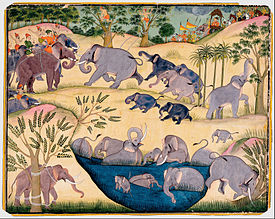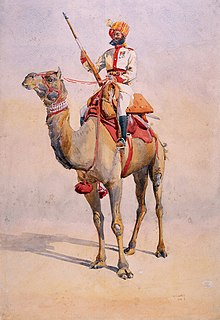State of Bikaner बीकानेर रियासत | |||||||
|---|---|---|---|---|---|---|---|
| 1465–1947 | |||||||
| Motto: "Jai Jungaldhar Badshah" Victory to the king of deserts | |||||||
 Bikaner State with Rajputana, in the Imperial Gazetteer of India (1909). | |||||||
| Official languages | Rajasthani and Hindi | ||||||
| Religion | Hinduism (state religion)[1] | ||||||
| Demonym(s) | Bikaner | ||||||
| History | |||||||
• Established | 1465 | ||||||
| 1947 | |||||||
| Area | |||||||
• Total | 60,391 km2 (23,317 sq mi) | ||||||
| Population | |||||||
• 1931 estimate | 936,218 | ||||||
| |||||||
| Today part of | Rajasthan, India | ||||||







Bikaner State was the Princely State in the north-western most part of the Rajputana province of imperial British India from 1465 to 1947. The founder of the state Rao Bika was a younger son of Rao Jodha ruler of and founder of the city of Jodhpur in Marwar. Rao Bika chose to establish his own kingdom instead of inheriting his father's. Bika defeated the Jat clans of Jangladesh which today refers to the north and north-western Rajasthan along with his uncle Rao Kandhal and his adviser Vikramji Rajpurohit and founded his own kingdom. Its capital was the city of Bikaner.
The state was noted for the Bikaner style of Miniature Painting.[2]
Covering a vast area of 60,391 km2 (23,317 sq mi)Bikaner State was the second largest state under the Rajputana Agency after Jodhpur State with a revenue of Rs.26,00,000 in the year 1901.[3] Heeding the 1947 call of Sardar Vallabhbhai Patel to integrate the princely states into the new independent India, Bikaner's last ruler, Maharaja Sadul Singh, advised by his dewan K. M. Panikkar a respected historian was one of the first rulers of a princely state to display willingness to join the Indian Union. By issuing a public appeal in April 1947 to his fellow princes to join the Constituent Assembly of India the Maharaja of Bikaner set an example for other heads of the native states to follow.[4]
- ^ "Bikaner State, Part I, Vol-I, Rajasthan – Linguistic Survey Of India" (PDF). LSOI. Retrieved 23 April 2021.
- ^ Harle, J. C., The Art and Architecture of the Indian Subcontinent, 2nd edn. 1994, Yale University Press. (Pelican History of Art). ISBN 0300062176.
- ^ "Imperial Gazetteer2 of India, Volume 8, page 214 – Imperial Gazetteer of India – Digital South Asia Library".
- ^ Ramachandra Guha, India after Gandhi: The History of the World's Largest Democracy. HarperCollins, 2007.

